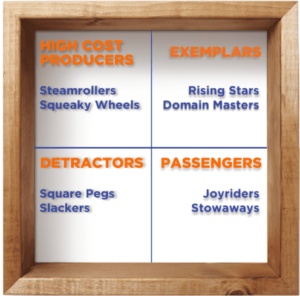Guest post by Mike Figliuolo
The phrase “think outside the box” makes me physically ill. It’s trite and it isn’t at all practical. But inside the box? That’s where great leaders go to get more out of their teams – preferably without exhausting themselves and others.
Preface: I’m an idiot. My friend and fellow thoughtLEADERS instructor Victor Prince hoodwinked me into co-authoring a new book: “Lead Inside the Box – How Smart Leaders Guide Their Teams to Exceptional Results”. Why am I an idiot? Because writing a book is a great deal of work and I’m already swamped running my business. Taking on a new project was tantamount to insanity. But the concepts he pitched me were so compelling, there’s no way I could have said no.
The premise of the book is you need to evaluate the amount of output you get from a team member and compare that to the amount of time and energy you have to invest in them to get it. Every leader wants their team to shine, but people development is often one of the most frustrating and difficult roles of a leader. When you compare the input of your time and energy and the output you get in the form of results from your team, you end up with some insightful observations.
As we discussed the results of those comparisons, we realized this approach was a fundamental building block for all leaders and we felt an obligation to document these thoughts and help other leaders become more efficient and effective. At our firm thoughtLEADERS, our mission is to teach managers around the world how to be great leaders. This book fit squarely within that charter.
The Box
The result of the comparisons between a leader’s input and the results they receive in return is the Leadership Matrix (or “the box” for short).
Along the horizontal axis is “leadership capital invested” – how much of your time and energy you are putting into this person. The left side of that axis is “a lot” and the right side is “very little” because the less leadership capital you have to invest in someone, the more efficient you are as a leader. The vertical axis is team member results. On the low end is “low results” and the high end is “high results.” Those axes then define the Leadership Matrix. Within that matrix, we define behavioral archetypes from Slackers to Rising Stars and everything in between.

The real insight lies in practical advice on how to lead those folks to improve their performance. By understanding the behaviors of your team members and how you invest (or don’t invest) your time and effort into them, you’ll get a clearer picture of the 8 archetypical behaviors that can show up in the box. With that understanding, you can begin leading differently which will improve your performance. Let’s examine those archetypes and as you read them, see if you recognize the performance patterns of some of your colleagues. If you’re truly up for a challenge in objectivity, assess where you yourself fall out on the Leadership Matrix…
Exemplars
Exemplars can be categorized based upon their career aspirations. Some Exemplars want their great performance to provide them a stepping stone to larger roles and responsibilities. These are the “Rising Stars.” Other Exemplars are content remaining in their current roles. They’re experts and they’re satisfied with delivering outstanding results without much interference from their boss. These individuals are the “Domain Masters.”
Detractors
Detractors are defined by the root cause of their performance issues. Some don’t have the skills they need to do their job. These individuals are the “Square Pegs.” We call Detractors who have the skills to do the job but they lack the will to do it the “Slackers.”
High Cost Producers
High Cost Producers break into subtypes based on the kinds of costs they incur. Some get results but at the high cost of damaging team morale and destroying the goodwill you and your team have accrued with others. These individuals are the “Steamrollers.” High Cost Producers who get results but require an inordinate amount of hand-holding from their leader to get them done are the “Squeaky Wheels.”
Passengers
Passenger subtypes are determined by the kind of output they produce. Some only work to get their paycheck. They expend the bare minimum amount of effort required to keep getting paid. These are the behaviors of your “Stowaways.” Other Passengers exert a great deal of energy but they focus on tasks they want to do, not tasks you need them to do. We refer to Passengers behaving this way as “Joyriders.”
To make it easy for you to evaluate your team, there’s an easy assessment online. You can use it to categorize your team member’s behavior and get practical advice on how to lead them.
The better you’re able to allocate your time and energy, the happier and more productive your team members will be. For folks requiring less of your time because they’re self-sufficient, you’ll pull back and give them the breathing room they’ve earned. For others who require more time and attention, you’ll now have that time available to invest in them. You can spend your time training, coaching, and developing them. That growth will enable them to deliver better results, get better ratings, and generally be happier in their role. Leaders will be more effective that way.
How to help people grow?
Before you go accusing us of being leadership CFO’s who look at this topic through the lens of ROI, weighing inputs and outputs, and calculating returns: we use this construct because it’s familiar to most business people. It serves as a simple metaphor for thinking through investing time and getting results. It helps people bridge from a typically quantitative mindset and look at a qualitative problem in a structured way. The placement of people’s performance on the Leadership Matrix is a simple way to start the right conversation with them and help leaders find appropriate leadership techniques that will be relevant to the challenges that individual faces.
Moving through boxes
One other thing to keep in mind – this isn’t about putting people in boxes. People change their positions on the Leadership Matrix – sometimes quite rapidly – based on their performance and the way their leader interacts with them. Personally, I’ve occupied every single one of these boxes over the course of my career. I’ve been a Rising Star when I worked for a great boss in a role I loved. I’ve been a Steamroller when I joined a new organization and my drive for results overwhelmed my understanding of the organization’s culture. I’ve been a Slacker when I had a boss who didn’t get along with me and I’ve been a Stowaway when I was less than satisfied with a different boss and the role he put me in.
The point is, people move. Sometimes they choose to improve their performance or change the way they interact with you and that results in a shift in where they appear on the Leadership Matrix. Other times, the leader changes their behavior and causes the shift. And that’s what this is all about – improving performance.
For each performance pattern in the Leadership Matrix, we offer some techniques for helping those individuals improve their performance while at the same time requiring less of your leadership capital. Here are a couple of summary examples of the guidance we provide. Recognize there’s a lot more detail underneath these recommendations:
For “The Squeaky Wheels”, seek to reduce the amount of leadership capital you invest in them. Squeaky Wheels produce above average results but seem to consume an above average amount of leadership capital to do so. They are regularly asking you for more budget and staff. They frequently need your help fixing problems and figuring out how to do their jobs. The leadership strategy we advocate for Squeaky Wheels is to “wean” them of their need for so much of your support. The goal with Squeaky Wheels is to get them to continue to deliver good results while reducing the resources they are consuming to get there. Make them less dependent on your help by making them figure out how to solve the problems they would often put in your lap.
For “Rising Stars” your goal is to move them to the next stage of their careers. The Rising Stars are fast rising talents. They have radically, and noticeably, improved how their jobs are done. Their excellent performance has been noticed by others and it is obvious these stars will be moving on to bigger and better things in the future. The leadership strategy to use with Rising Stars is “Promote Internally.” You acknowledge their reliable performance and reduce the amount of supervision you are providing them, thereby freeing up some of your leadership capital. Your goal should be to help them advance toward their career goals while retaining them in your larger organization.
Each of the eight archetypes in the Leadership Matrix point to specific techniques for leading them more efficiently and effectively. You can figure out which box your team members are currently occupying and then put into action a plan to move them to a position of improved performance.
If you’re interested in looking at your team and the way you interact with them in a new way, spend a few moments evaluating the members of your team via this assessment.
* In which boxes have you found yourself throughout your career?
Let me know in the comments!
Mike Figliuolo is the co-author of Lead Inside the Box: How Smart Leaders Guide Their Teams to Exponential Results
He’s the managing director of thoughtLEADERS LLC and regularly writes about leadership on his blog.
 Do you like this post? Please help me spread positivity by tweeting, sharing, and liking.
Do you like this post? Please help me spread positivity by tweeting, sharing, and liking.
3 Responses
Love the matrix and the labels!
A good paper indeed. Thank you for sharing
To help leaders effectively & efficiently lead & manage teams, the author shares an easy to use leadership matrix that identifies eight prototypical follower behaviours, encourages self and team evaluation & “the placement of people’s performance on the leadership matrix” to identify performance gaps & remedial measures . The invitation to “thinking inside the box” is an interesting play on words, suggesting “that’s where great leaders go to get more out of their teams – preferably without exhausting themselves and others”.
The matrix appears to be a useful technique in & of itself, something to be kept in the repertoire of tools for managing employee performance. Great read…….thanks for posting !